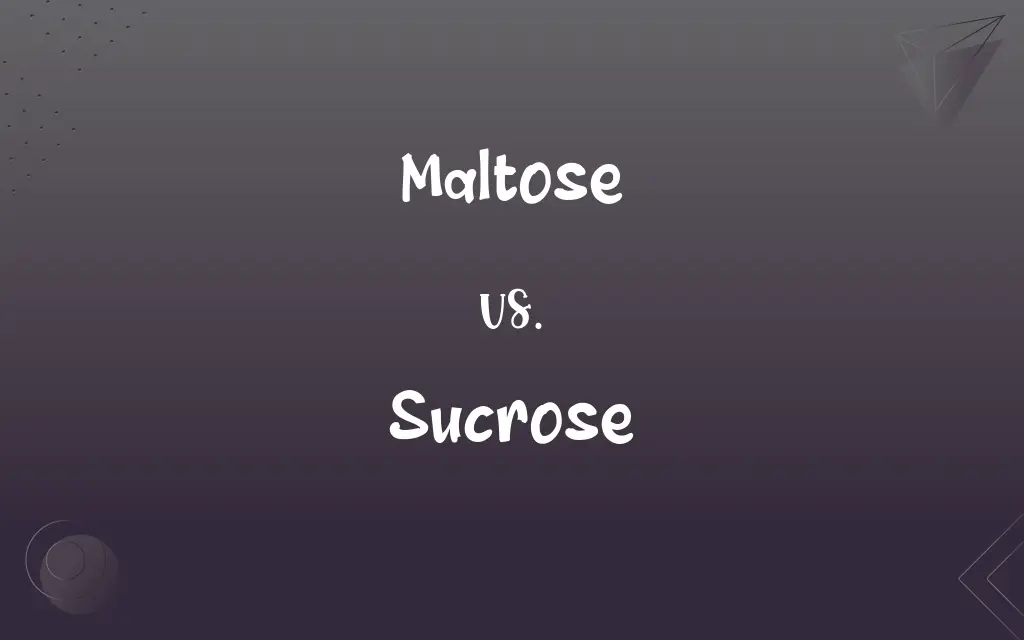Maltose vs. Sucrose: What's the Difference?
Edited by Aimie Carlson || By Janet White || Published on December 28, 2023
Maltose, a disaccharide of two glucose molecules, is less sweet, produced during starch breakdown; sucrose, a glucose-fructose disaccharide, is table sugar, naturally found in plants.

Key Differences
Maltose, known as malt sugar, is formed by two glucose units linked together. It is a product of starch digestion, commonly found in germinating grains and brewing processes. Sucrose, on the other hand, is a combination of glucose and fructose, widely known as table sugar. It is naturally present in many plants, especially in sugar cane and sugar beets, and is a primary source of sweetness in the human diet.
In terms of sweetness, maltose is considerably less sweet than sucrose. This characteristic of maltose makes it a preferred choice in certain food preparations where a mild sweetness is desired. Sucrose, with its higher sweetness level, is a dominant sweetener used in a wide range of food products, from baked goods to beverages.
Digestion and absorption of these sugars also differ. Maltose is broken down by the enzyme maltase into two glucose molecules, which are easily absorbed by the body. Sucrose, however, requires the enzyme sucrase to split it into glucose and fructose, which are then absorbed separately. This difference in digestion can have varying impacts on blood sugar levels.
In terms of usage, maltose finds its application mainly in brewing and in the production of certain Asian foods. Its ability to contribute to the fermentation process is highly valued in beer production. Sucrose, being a versatile sweetener, is ubiquitous in the food industry, from confectioneries to preservatives.
Comparison Chart
Composition
Two glucose units
One glucose and one fructose
ADVERTISEMENT
Sweetness
Less sweet
More sweet
Source
Starch digestion, brewing
Plants, especially sugar cane
Digestion
Broken down by maltase
Broken down by sucrase
Primary Use
Brewing, Asian foods
Widespread food sweetener
Maltose and Sucrose Definitions
Maltose
Maltose is a sugar formed from two glucose molecules.
Barley malt contains maltose, contributing to beer's flavor.
ADVERTISEMENT
Sucrose
Sucrose consists of glucose and fructose.
Sucrose in fruits adds to their natural sweetness.
Maltose
Maltose is less sweet than sucrose.
Maltose is often used in candy making for its subtle sweetness.
Sucrose
Sucrose is common table sugar, a disaccharide.
Sucrose is used in coffee to enhance its sweetness.
Maltose
Maltose is a product of enzymatic action on starch.
Maltose is formed when amylase breaks down starch in grains.
Sucrose
Sucrose is naturally found in plants.
Sugar cane and beets are major sources of sucrose.
Maltose
Maltose is involved in the brewing process.
The maltose in malted barley is crucial for brewing beer.
Sucrose
Sucrose is widely used as a sweetener in foods.
Sucrose is a key ingredient in chocolate chip cookies.
Maltose
Maltose is a disaccharide produced during starch breakdown.
When bread is baked, the yeast ferments maltose for leavening.
Sucrose
Sucrose is broken down into glucose and fructose.
The sucrase enzyme helps digest sucrose in the human diet.
Maltose
A white disaccharide, C12H22O11, formed during the digestion of starch. Also called malt sugar.
Sucrose
A crystalline disaccharide of fructose and glucose, C12H22O11, extracted chiefly from sugarcane and sugar beets and commonly known as table sugar. Also called saccharose.
Maltose
(carbohydrate) A disaccharide, C12H22O11 formed from the digestion of starch by amylase; is converted to glucose by maltase; it is an isomer of trehalose
Sucrose
(carbohydrate) A disaccharide with formula C12H22O11, consisting of two simple sugars, glucose and fructose; normal culinary sugar.
Maltose
A crystalline disaccharide (C12H22O11) formed from starch by the action of diastase of malt, and the amylolytic ferment of saliva and pancreatic juice; called also maltobiose and malt sugar. Chemically it is 4-O-
Sucrose
A common variety of sugar found in the juices of many plants, as the sugar cane, sorghum, sugar maple, beet root, etc. It is extracted as a sweet, white crystalline substance which is valuable as a food product, and, being antiputrescent, is largely used in the preservation of fruit. Called also saccharose, cane sugar, etc. At one time the term was used by extension, for any one of the class of isomeric substances (as lactose, maltose, etc.) of which sucrose proper is the type; however this usage is now archaic.
Maltose
A white crystalline sugar formed during the digestion of starches
Sucrose
A complex carbohydrate found in many plants and used as a sweetening agent
FAQs
Is maltose naturally occurring?
Yes, especially in germinating grains and brewing processes.
Where does sucrose come from?
It's naturally found in plants, especially sugar cane and beets.
What is maltose?
Maltose is a sugar made of two glucose molecules.
How sweet is maltose compared to sucrose?
Maltose is less sweet than sucrose.
What is sucrose?
Sucrose is table sugar, a glucose-fructose disaccharide.
How is maltose produced?
It's produced during starch digestion, especially in grains.
Where is maltose commonly used?
In brewing and certain Asian cuisines.
Is sucrose sweeter than maltose?
Yes, sucrose is sweeter than maltose.
Can sucrose cause health problems?
Excessive intake can lead to health issues like obesity and diabetes.
How is sucrose used in the food industry?
As a sweetener in various foods and beverages.
How is sucrose digested?
It's split into glucose and fructose by the enzyme sucrase.
What makes sucrose important in diets?
It's a major source of energy but should be consumed in moderation.
Is maltose vegan?
Yes, it's derived from plants and is suitable for vegans.
Is sucrose a preservative?
Yes, it's often used to preserve and sweeten jams and jellies.
Is maltose good for health?
In moderation, but excessive intake can raise blood sugar levels.
Does maltose have any health benefits?
It's a quick energy source, but benefits are similar to other sugars.
Can maltose be used in baking?
Yes, especially in certain specialty breads and Asian pastries.
Can maltose affect blood sugar levels?
Yes, it's broken down into glucose, affecting blood sugar.
Is sucrose vegan?
Generally, yes, but some refining processes may use animal products.
What is the difference in digestion between maltose and sucrose?
Maltose is broken down by maltase, while sucrose is split by sucrase.
About Author
Written by
Janet WhiteJanet White has been an esteemed writer and blogger for Difference Wiki. Holding a Master's degree in Science and Medical Journalism from the prestigious Boston University, she has consistently demonstrated her expertise and passion for her field. When she's not immersed in her work, Janet relishes her time exercising, delving into a good book, and cherishing moments with friends and family.
Edited by
Aimie CarlsonAimie Carlson, holding a master's degree in English literature, is a fervent English language enthusiast. She lends her writing talents to Difference Wiki, a prominent website that specializes in comparisons, offering readers insightful analyses that both captivate and inform.































































